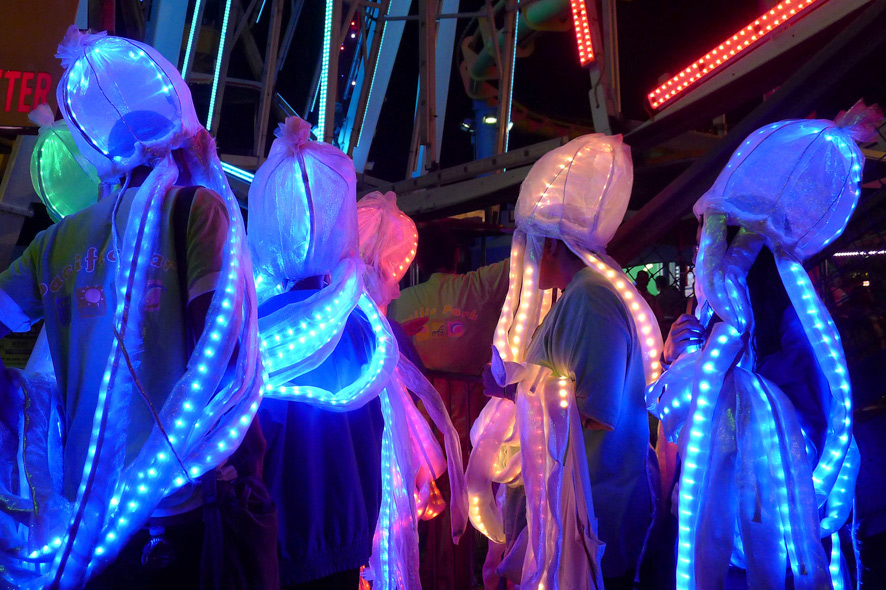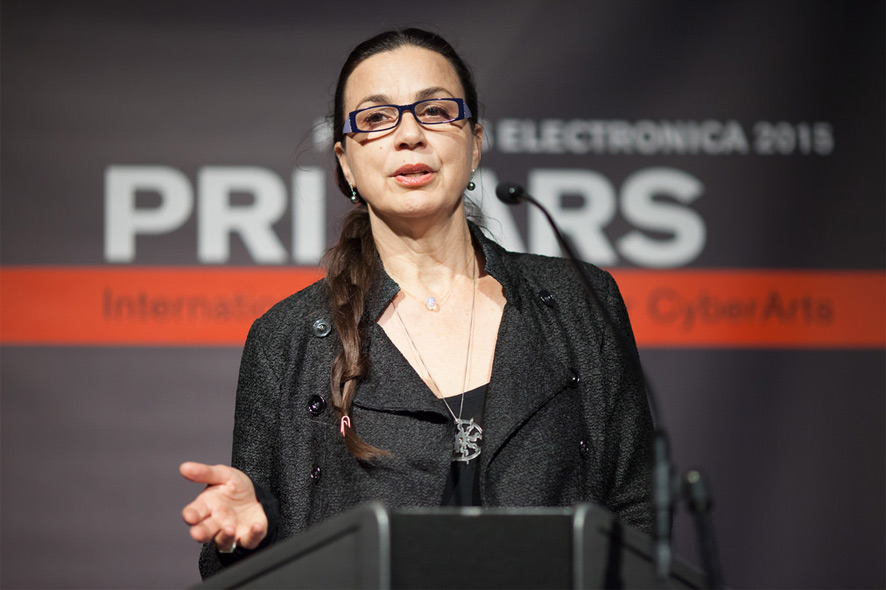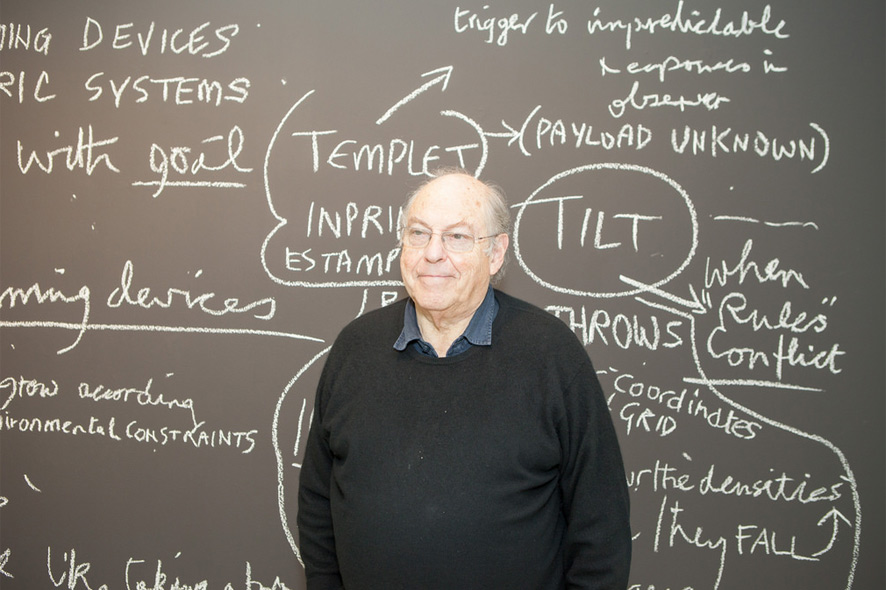What does interactive actually mean? We touch something and then experience the upshot of that act? Or does interactivity already come about when we view an image? Victoria Vesna, a 2016 Prix Ars Electronica juror, talked to us about defining interactive art, and elaborated on something she learned about it from media artist Roy Ascott.
Interactive Art has been a category in its own right at the Prix Ars Electronica, the world’s most time-honored competition in the media arts, ever since 1990. That the definition of this genre’s purview is now being expanded somewhat is suggested by the plus symbol appended to the category’s title, Interactive Art +, though this is by no means an attempt to rock its conceptual foundations. Victoria Vesna, an artist and professor, is once again enriching the Prix Ars Electronica judging process with her experience as well as her expertise that has been significantly shaped by encounters with media art pioneer Roy Ascott. But why don’t we let her tell this story herself!
And don’t forget—March 13th is the deadline for submitting works for 2016 Prix Ars Electronica prize consideration. Cash awards of up to €10,000 await the winners in each category. Details are online at ars.electronica.art/prix!
Victoria Vesna during the 2015 Ars Electronica Festival, Credit: Florian Voggeneder
What’s your understanding of interactive elements?
Victoria Vesna: Some may argue that everything we do in relation to an object could be interpreted as interactive – that even passively watching a painting could be viewed as a certain interaction. On the opposite side of the spectrum, there are those who insist that interactivity means some kind of action/reaction between the (art) object/person and/or installation and is necessarily technological/digital. In my work, I explored both approaches and also the concept of no movement creating an effect and stillness being the action – the idea of reverse interactivity.
“In the end, all variations are about raising awareness of the interconnectivity of everything and everyone and the collaborative interaction between the artist and the audience – through various expressions that can range in a number of manifestations. Technology is or should be utilized to amplify the experience and/or the range of influence.” Victoria Vesna
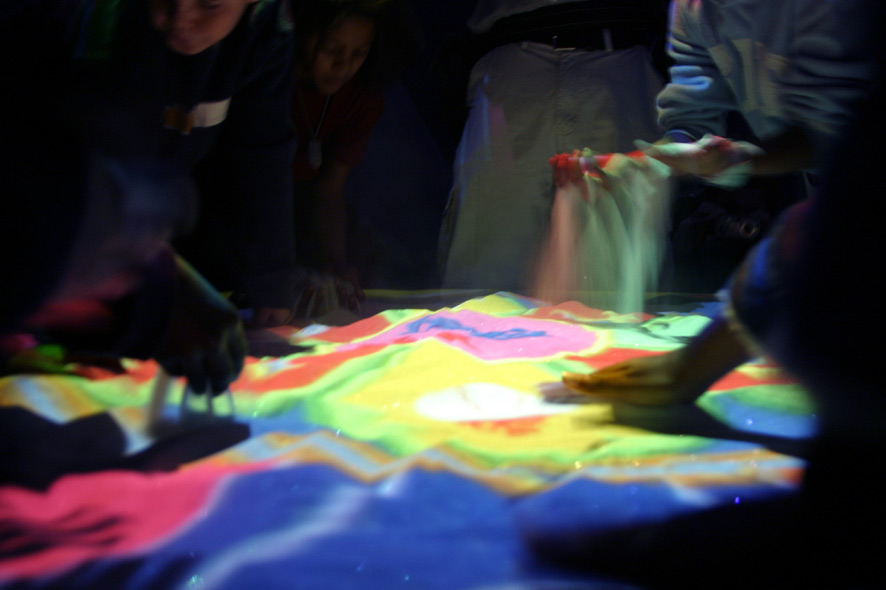
NanoMandala, Credit: Victoria Vesna
I think about this from time to time as I was trained early on as a painter and on some level still think like one – even when working with the most elaborate technological interactive works involving sensors, STM imaging and artificial life. How does one create an experience that immerses the audience in a way that changes their perception of the subject matter? This is the core challenge of interactive art and made most obvious when computers are involved.
As an example, a decade ago, while working on the NanoMandala with nanoscientist James Gimzewski and Tibetan monks from Gaden Shartze Monastery, I first utilized sensors and an elaborate interactive program for the installation. But as I watched people interact simply by touching the sand and thus influencing the projections, I realized that the overt technical interactivity was more of a distraction.
“This piece helped me form an opinion that technological interactive elements are an addition to the artist’s palette and should be used prudently – when necessary to enhance the experience.” Victoria Vesna
The + sign resides somewhere in between – it is about recognizing pieces that have subtle forms of interaction that go beyond passive viewing but have an influence on the work through presence and movement. Ultimately, the + sign is an indication that the categories are expanding before they dissolve and/or get redefined.
You did a Ph.D. at the Centre for Advanced Studies in Interactive Arts at the University of Wales in 2000. What do you think belongs to the main changes that happened to interactive arts within the last 16 years?
Victoria Vesna: Yes, I completed my PhD in 2000 so it is exactly 20 years since I started my studies with Roy! Perhaps the biggest difference is the ubiquity of computing and networks that are creating a new way of being and interacting in daily life. By default, this makes the audience relate and expect a more complex message from the pieces that utilize technological interactivity. In other words, just as the power of large rooms of early computers are now equivalent to the mobile phones, so too the possibilities and perception of interactivity and the social networks are perhaps the biggest change.
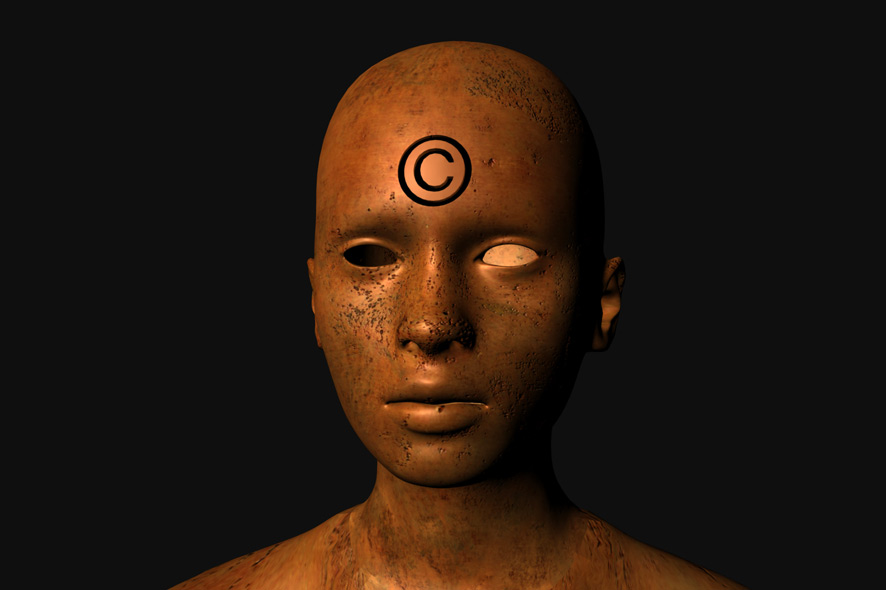
Bodies Corp 2.0, Credit: Victoria Vesna
Much that was theoretical and visionary at the time is now commonplace and mundane. For instance, for my thesis I developed two online projects: Bodies INCorporated in which all of your personal data was owned by a Corporate body and you had no rights, and that of the Information Personae (note the plural) – a work that maps your connections to others and your value and power in society would be based on the amount of time people would spend on your information. I called this project N0time: Building a Community of People with No Time. Although created somewhat cynically, it all seems to have come true and now this is common-place and these new ways of social interaction and market power structures are normalized. I have a draft of Bodies Corp 2.0 in which the corporation “protects” your third eye and your unconscious mind – transactions are made with bitcoin and all is on a cloud…
“Interactive arts face a similar but more complex dilemma as video art did at one point – how to elevate the medium or use it in a way that gives the user or the participants another point of view when everyone is interacting with familiar technological devices? This is the challenge of artists regardless of the media, but somehow now is more demanding in many ways in our complex contemporary societal condition.” Victoria Vesna
Also, our attention has moved from the purely technological fascination to looking at the interaction of natural bio-systems and computers and there is a surge of interaction with the sciences. I believe that this is a major shift – we are just starting to sense where the collective mind is going and it is all happening at the same time, so interacting with the sciences becomes necessary to make sense of the confusion.
Roy Ascott, awarded as a Visionary Pioneer of Media Art in 2014, Credit: Florian Voggeneder
Roy Ascott, a pioneer of interactive art, is one of your most influential mentors – could you please tell us more about what you’ve learned from him?
Victoria Vesna: I met Roy very early on – in 1986 Venice Biennale. I was just out of the Academy of Fine Arts in Belgrade and by incredible luck was invited by curator Biljana Tomić to participate in Aperto – the emerging artists section that is not in existence anymore. Next to my installation was Brian Eno, who was Roy’s student and was visited by him on site from time to time – so I met both of them. This meeting opened a whole new world for me – up to that point I separated my artwork from my music experimentations (band:), and was stunned to see these connections being made by them both. Brian was showing his light and sound boxes and Roy Ascotts “Planetary Network” was something I was not able to compute at that point literally. Incredibly, the thematic of the Biennale was “Art and Science”, directed by art historian Maurizio Calvesi.
Looking back, I think that at that point, Roy had a powerful influence on my unconscious, as soon after, my work started to change radically and I was drawn to learning how to use the computer and connect to the Internet. I dove into this world with no roadmap and no mentor – somehow navigated through pure intuition and started creating interactive works. Six years later, when I presented the Interactive tree project (Another Day in Paradise) in ISEA 92, I met Roy once again and he invited me to join his new CAiiA PhD program. I was already tenured at UC Santa Barbara so there was no need for the degree, but I had a thirst for contextualizing my work historically, learning how to write critically and engage scientists and humanists more effectively. Roy provided this and also showed me how important teaching is – that it is an honor and that it is critical to challenge the existing educational system in action – to engage in academia as a kind of social sculpture. He also taught me not to be afraid to bring up the spiritual aspect – usually frowned on in academia, and encouraged me to explore the unknown. His path was not so easy and this was important to witness as well – every great proposition has an equally great opposition—but we have to not take it personally and just forge ahead with the persistence of vision.
“I often quote him as saying that “after the third drink, there are no disciplines” and take this quite seriously as a technique of bringing people of seemingly disparate interested together. Gatherings and parties are important – we have to speak to each other as human beings first.” Victoria Vesna
Apart from your teaching roles, on which artistic projects are you currently working on?
Victoria Vesna: My work takes a relatively long time to mature – about 4-5 years and projects run in parallel and inform each other and also trickle into my teaching. Two projects are close to full completion – Bird Song Diamond and Hox Zodiac dinners, and two are waiting on the side-lines for my attention and the right circumstance – Octopus Mandala and Brain Storming.
For the first time, after a very long period I am on sabbatical this year and the timing and circumstance was perfect to put my full attention on these two works. Summer and Fall last year, I was an artist in residence at the Angewandte in Vienna and there I focused on the Hox Zodiac dinner project. In the Winter, I was a Visiting Professor at the University of Tsukuba in Japan and I had an opportunity to work with a big team on Bird Song Diamond Japan. Hox Zodiac is a collaboration with neuroscientist Siddharth Ramakrishnan and Bird Song Diamond with evolutionary biologist Charles Taylor, physicist Takashi Ikegami and most recently, engineer Hiroo Iwata.
Hox Zodiac is a good example of a work that started as an interactive piece and then evolved to be pretty much unplugged – with food being at the center and the participants the performers. Briefly – the hox gene determines our limbs and is present in all living beings – from the snail to the elephant and the Chinese zodiac assigns an animal to humans and gets quite complex with the Chinese medicine and the I Ching. It started as a way to bring people together and through food, discuss the way animals are bred, eaten, domesticated and used in scientific research. In Vienna, I worked with the designers at the academy at the invitation of Barbara Putz-Plecko and together we hosted two dinners – private and public at the Innovation Lab and the piece evolved beautifully. Next week, Siddharth and I are hosting the dinner at the Museum of Natural History in Seattle and I am just preparing for this.
In Tsukuba, together with a great interdisciplinary team, I was able to further develop Bird Song Diamond in the Large (VR) Space created by Hiroo Iwata. The piece was initiated by evolutionary biologist Charles Taylor who is an expert in artificial life and put me on his NSF grant for a research project Mapping the Acoustic Network on Birds. This evolved into the largest collaboration I have attempted to date – it was truly like an orchestra – there were so many amazing people involved between PhD students at the EMP program and physicist Takashi Ikegami’s group. Now here is an example where the technological interactive elements make full sense and group work is absolutely necessary for the concept of the work. The piece was already developed conceptually and aesthetically and successfully presented the at Electronic Media Arts Festival at Governor’s Island and in the middle of Times Square in New York.
But, there were some technological elements that were still pretty prototypical and a bit shaky so having the Large Space and a team of EMP students and engineers was fantastic. Plus, I was able to focus on the collaboration with physicist Takashi Ikegami and sound artist Itsuki Doi from Tokyo University on the artificial life bird boids and acoustics – together we made a quantum leap in the project. This large collaboration had biologists, physicists, computer scientists, engineers, sound and media artists working together and that is what the idea of the diamond is – reflection on the idea from many different angles with the audience perception being equally different depending on their point of view.
It emerged through self-organized criticality as a work that reflects on the natural (birds) and artificial (drones) worlds colliding through the people that influence both with their actions and are influenced by their interaction. Obviously this is not something that can be replicated easily as the space is unique, so I was thinking about elements of the piece in a modular way and we also further developed the Bird Song mimic piece that is easily set up and transportable. Both works are solid now and I am working on the documentation and web site – so stay tuned!
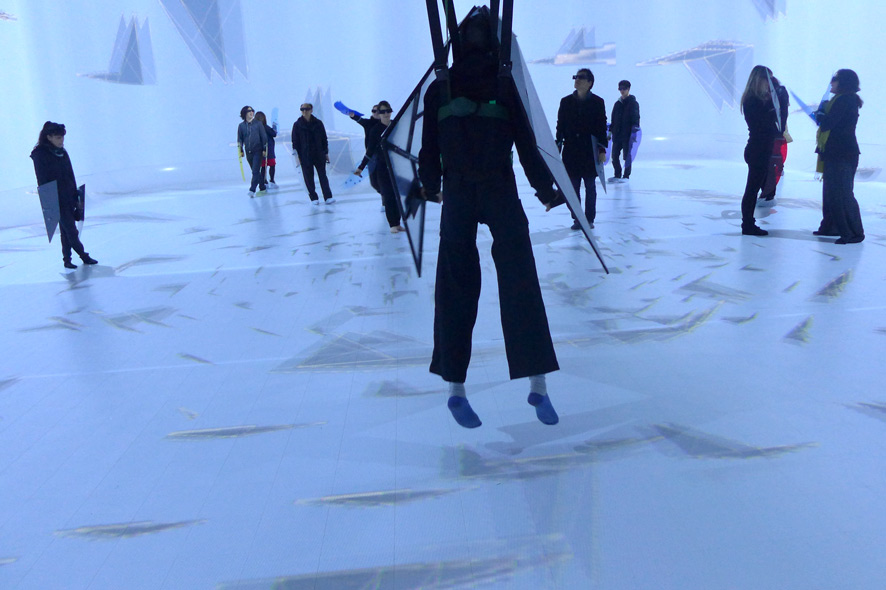
Bird Song Diamond in Japan, Credit: Victoria Vesna
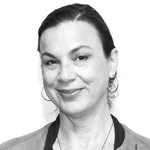
Victoria Vesna, Ph.D., is an Artist and Professor at the UCLA Department of Design | Media Arts and Director of the Art|Sci center at the School of the Arts and California Nanosystems Institute (CNSI). With her installations she investigates how communication technologies affect collective behavior and perceptions of identity shift in relation to scientific innovation (PhD, University of Wales, 2000). Her work involves long-term collaborations with composers, nano-scientists, neuroscientists, evolutionary biologists and she brings this experience to students. She is the North American editor of AI & Society and in 2007 published an edited volume – Database Aesthetics: Art in the Age of Information Overflow and another in 2011 – Context Providers: Conditions of Meaning in Media Arts.
